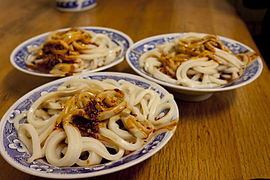This article needs additional citations for verification .(June 2019) |
- ↑ Sarah (19 July 2020). "Spicy Cold Skin Noodles (Liangpi)". The Woks of Life. Retrieved 19 March 2024.
- ↑ 金瀚方大健康平台. "秋夏季节交替的美食宠儿——凉皮". Weixin Official Accounts Platform. Retrieved 19 March 2024.
- ↑ "凉皮——详细制作过程教你做陕西风味小吃", 23 July 2008.
- ↑ "凉皮的灵魂—"蒸面筋",蓬松多孔又劲道,让你一次吃过瘾!". sohu.com. 24 July 2021.
- ↑ 张, 大为 (2005). "陕西名吃-"秦镇凉皮"与"肉夹馍"". 美食. 3: 40.
- ↑ "一碗汉中面皮 蒸出幸福味道 - 社会新闻 - 汉中市人民政府". www.hanzhong.gov.cn. Retrieved 2024-03-19.
- ↑ "刘邦与汉中凉皮". 饮食与健康(下旬刊). 2. 2010.
- ↑ Goldberg, Lina (22 February 2013). "Asia's 10 greatest street food cities". CNN Travel. Retrieved 24 February 2013.
- ↑ 裴逸萱. "走近非遗看宝鸡|岐山擀面皮制作技艺". Weixin Official Accounts Platform. Retrieved 19 March 2024.
External links
| Liangpi | |
|---|---|
 Liangpi |
| Variants |
| ||||||||||||||||||||||||||||
|---|---|---|---|---|---|---|---|---|---|---|---|---|---|---|---|---|---|---|---|---|---|---|---|---|---|---|---|---|---|
| Dishes |
| ||||||||||||||||||||||||||||
| Instant noodle brands | |||||||||||||||||||||||||||||
| List articles | |||||||||||||||||||||||||||||
| See also | |||||||||||||||||||||||||||||